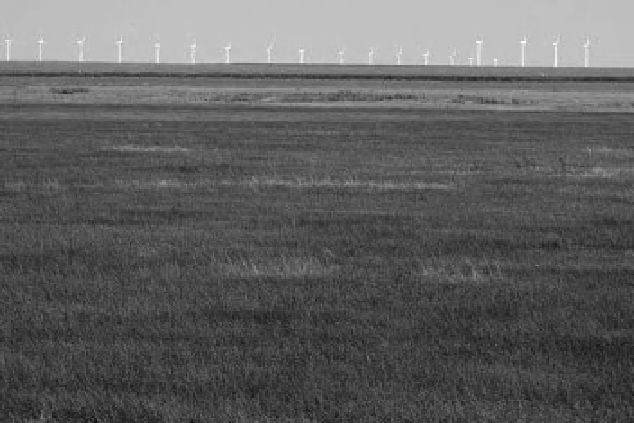Geoscience Reference
In-Depth Information
Figure 12-7.
Playa-marsh landscape in the foreground is enrolled in the U.S. Wetland Reserve Program. Wind farm
in the background has minuscule environmental impact on the wetland habitat. Photo by J.S. Aber, southwestern
Kansas.
conservation of environmentally sensitive areas
through incentive programs that are funded
jointly by the EU and member nations (Shine
and de Klemm 1999). These programs have
been implemented widely across EU nations.
As Shine and de Klemm (1999) outlined, the
Countryside Stewardship Scheme implemented
in the United Kingdom provides payments to
landowners for wetland-based rehabilitation
and restoration efforts. In Australia, programs
offer property tax rate rebates and concessions
to landowners who voluntarily conserve wet-
lands and rehabilitate native vegetation (Whitten
et al. 2002).
Beyond these formal and informal mecha-
nisms to promote conservation best practices
applicable to wetland settings, institutional ecol-
ogists have suggested that strengthening stake-
holdership in a resource and making property
regimes relevant and responsive to dynamic
local conditions are important considerations.
More recently, green labeling and certii cation
aim to connect the supply and demand side of
products by recognizing those producers that
intentionally engage in biodiversity preservation
or practice sustainable extraction methods. Such
efforts may have indirect impacts on wetlands,
although the reliability of certii cation and labe-
ling programs has been questioned by some.
The peat producers Fafard et Frères and Premier
Tech Horticulture in Québec, Canada, became
the i rst companies worldwide to obtain Veri-
Flora certii cation in 2010 for responsible man-
agement of peatlands (
Peat News
2010). This
certii cation assures that good management
practices are followed in all phases of peat
extraction and bog restoration in order to
achieve sustainable development.
12.5 Summary
This chapter provides a brief history of conser-
vation thought in the United States, Europe,
and elsewhere. The review suggests that there
was a great deal of cross-fertilization of conser-
vation ideas between different countries during
the nineteenth century. Moreover, European
colonialism spread these ideas and practices
across parts of Africa and Asia. While wetlands
did not i gure prominently in discussions on
conservation during this early period, the
wetland conservation policies and practices
implemented today rest on this shared history
and knowledge.
Scientists have recognized the importance of
approaching wetland management from an inte-
grated systems perspective. Such an approach
ensures that the multifaceted nature of wetland
ecosystems and their complex interactions are






